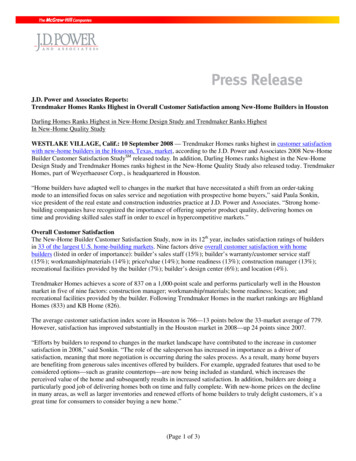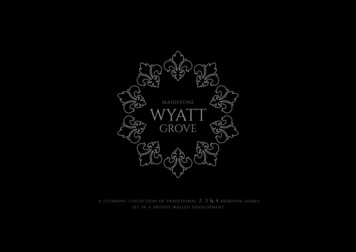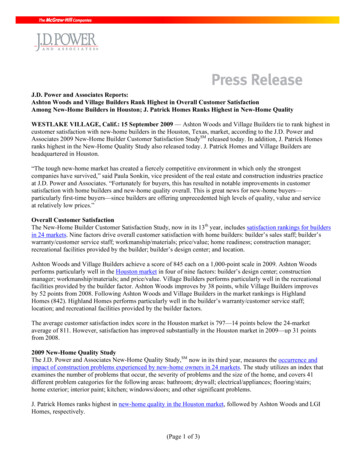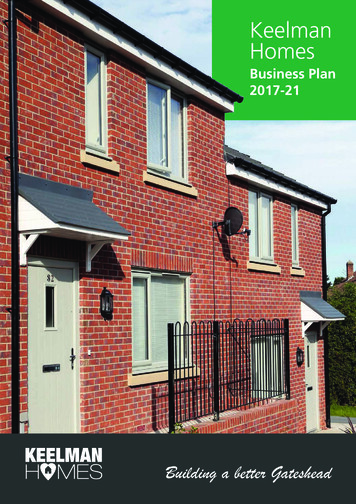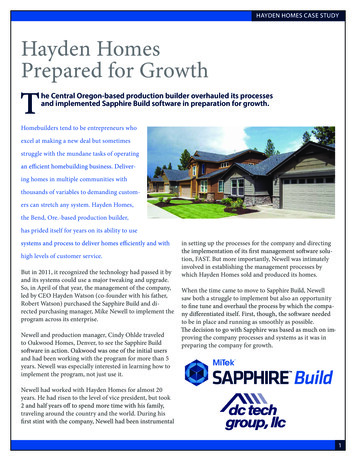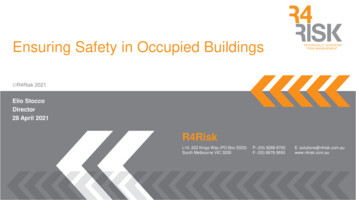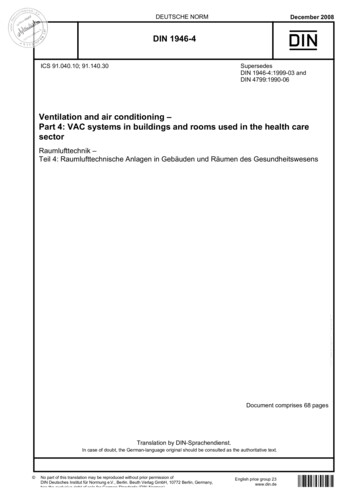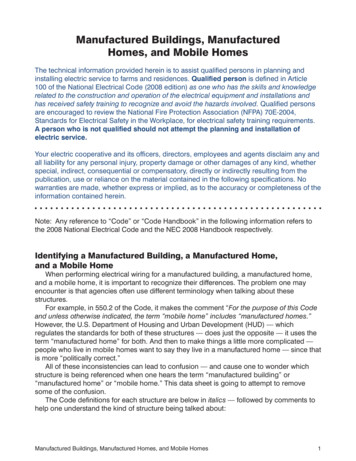
Transcription
Manufactured Buildings, ManufacturedHomes, and Mobile HomesThe technical information provided herein is to assist qualified persons in planning andinstalling electric service to farms and residences. Qualified person is defined in Article100 of the National Electrical Code (2008 edition) as one who has the skills and knowledgerelated to the construction and operation of the electrical equipment and installations andhas received safety training to recognize and avoid the hazards involved. Qualified personsare encouraged to review the National Fire Protection Association (NFPA) 70E-2004,Standards for Electrical Safety in the Workplace, for electrical safety training requirements.A person who is not qualified should not attempt the planning and installation ofelectric service.Your electric cooperative and its officers, directors, employees and agents disclaim any andall liability for any personal injury, property damage or other damages of any kind, whetherspecial, indirect, consequential or compensatory, directly or indirectly resulting from thepublication, use or reliance on the material contained in the following specifications. Nowarranties are made, whether express or implied, as to the accuracy or completeness of theinformation contained herein.Note: Any reference to “Code” or “Code Handbook” in the following information refers tothe 2008 National Electrical Code and the NEC 2008 Handbook respectively.Identifying a Manufactured Building, a Manufactured Home,and a Mobile HomeWhen performing electrical wiring for a manufactured building, a manufactured home,and a mobile home, it is important to recognize their differences. The problem one mayencounter is that agencies often use different terminology when talking about thesestructures.For example, in 550.2 of the Code, it makes the comment “For the purpose of this Codeand unless otherwise indicated, the term “mobile home” includes “manufactured homes.”However, the U.S. Department of Housing and Urban Development (HUD) — whichregulates the standards for both of these structures — does just the opposite — it uses theterm “manufactured home” for both. And then to make things a little more complicated —people who live in mobile homes want to say they live in a manufactured home — since thatis more “politically correct.”All of these inconsistencies can lead to confusion — and cause one to wonder whichstructure is being referenced when one hears the term “manufactured building” or“manufactured home” or “mobile home.” This data sheet is going to attempt to removesome of the confusion.The Code definitions for each structure are below in italics — followed by comments tohelp one understand the kind of structure being talked about:Manufactured Buildings, Manufactured Homes, and Mobile Homes1
Manufactured Building — 545.2 of the Code defines a manufactured building as anybuilding that is of closed construction and is made or assembled in manufacturing facilitieson or off the building site for installation, or for assembly and installation on the building site,other than manufactured homes, mobile homes, park trailers, or recreational vehicles. often called a modular home or factory-built home or prefab home come from the factory in completed sections including sheet-rocked walls, hardwoodfloors, kitchen cabinets hung, appliances in place, fully furnished bathrooms — even thesiding and the window shutters are pre-hung. At the building site, these house sectionsare lifted onto the foundation by a crane where they are permanently anchored. contractor hooks up water and electricity, adds any decks or patios, builds the garage,and completes the inside finish work must conform to the building codes for the locations where they are erected. consists of the closed construction type which means that all concealed parts ofprocesses of manufacture cannot be inspected without disassembly, damage, ordestruction. finished walls are either already coated with a primer allowing the owner to choose thefinal paint color or may be the finished color. can be single- or two-story The following comments are from the Regulation of Factory Built Structures in Illinois:This type of unit is called a “manufactured housing unit” or “modular dwelling” or“modular home” and is defined as “a building assembly or system of building subassemblies, designed for habitation as a dwelling for one or more persons, includingthe necessary electrical, plumbing, heating, ventilating and other service systems,which is of closed or open construction and which is made or assembled by amanufacturer, on or off the building site, for installation, or assembly and installation,on the building site, with a permanent foundation.” A permanent foundation means aclosed perimeter formation consisting of materials such as concrete or concrete blockwhich extends into the ground below the frost line.These types of units may be either panelized (floor, wall and roof panels are assembledat the final site) or sectional (the home is shipped as a box-like configuration).Each modular dwelling unit in Illinois shall bear an Illinois seal (see sample below)unless the unit bears a seal from a state which has a reciprocity agreement with thisState — and the approved inspection agency must also place a label of approval onthe finished unit and provide a copy of the inspection report of the structure to themanufacturer.1. The seal and label shall be placed on the unit before it is shipped from the plant.A code compliance certificate is required for all units manufactured or offered forsale or rent for location in Illinois.2. The Illinois seal and the label of the approved inspection agency that inspected thestructure shall be placed on the electrical panel box of the modular dwelling unit.Manufactured Buildings, Manufactured Homes, and Mobile Homes2
Seal No.17400Compliance Cert. No.Manufacturer:Date Manufactured:Model:Manufacturer’s Serial No.:Department Plan Approval No.Design Live Loads:Roof: PSFFloor: PSFDesign Wired Load: PSFSeismic Zone:The manufacturer of the factorybuilt structure certifies that thisunit complies with the IllinoisManufactured Housing andMobile Home Safety Act andrules promulgated by theIllinois Department ofPublic Health.Manufactured Buildings, Manufactured Homes, and Mobile Homes3
Manufactured Home — 550.2 of the Code defines a manufactured home as a structure,transportable, in one or more sections, that in the traveling mode is 8 body-ft or more inwidth or 40 body-ft in length, or when erected on site, is 320 ft squared or more and thatis built on a permanent chassis and designed to be used as a dwelling, with or without apermanent foundation, when connected therein. The term “manufactured home” includesany structure that meets all the provisions of this paragraph except the size requirements andwith respect to the manufacturer voluntarily files a certification by the regulatory agency, andexcept that such term does not include any self-propelled recreational vehicle. Calculationsused to determine the number of square feet in a structure are based on the structure’sexterior dimensions, measured at the largest horizontal projections when erected on site.These dimensions include all expandable rooms, cabinets, and other projections containinginterior space but do not include bay windows. For the purpose of this “Code” and unlessotherwise indicated, the term “mobile home” includes manufactured homes. built in a factory on a non-removable steel chassis sections are transported to the building site on their own wheels wheels can be removed but the chassis stays in place multi-part manufactured units are joined at their destination. not always placed on a permanent foundation sometimes referred to as a “double wide” often called “HUD homes” since the Department of Housing and Urban Development(HUD) establishes the construction standards — rather than to building codes at theirfinal destination building inspectors check the work done locally (utility hook up, etc.) but are not requiredto approve the structure See section below entitled Labels Required for Manufactured Homes and Mobile HomesMobile Home — 550.2 of the Code defines a mobile home as a factory-assembled structureor structures transportable in one or more sections that are built on a permanent chassisand designed to be used as a dwelling without a permanent foundation where connected tothe required facilities and that include the plumbing, heating, air-conditioning, and electricalsystems contained therein. For the purpose of this Code and unless otherwise indicated, theterm “mobile home” includes manufactured homes. mobile homes are just that — they are structures that are mobile distinguishable by their own set of “wheels” — although HUD requires these and thehitch to be removed once at final location commonly referred to as “trailers” by the older generation — although this term isnot politically correct anymore. Starting to be referred to more and more often asmanufactured homes not placed on a permanent foundation — rather the perimeter of the mobile home has askirting See section below entitled Labels Required for Manufactured Homes and Mobile HomesLabels Required for Manufactured Homes and Mobile HomesThe Certification Label — also know as a HUD tag, HUD label, or HUD seal — is a redmetal plate that is affixed to the outside of the manufactured home and a mobile home. It islocated near the floor level — at the end opposite the towing hitch. HUD requirements state,“The label shall be approximately 2 in. by 4 in. in size and shall be permanently attached toManufactured Buildings, Manufactured Homes, and Mobile Homes4
the manufactured home by means of 4 blind rivets, drive screws, or other means that renderit difficult to remove without defacing it. The label number shall be etched or stamped witha 3 letter designation which identifies the production inspection primary inspection agency,and which the Sectary shall assign. Each label shall be marked with a 6 digit number whichthe label supplier shall furnish. The labels shall be stamped with numbers sequentially.”(See sample of Certification Label below.)AS EVIDENCED BY THIS LABEL NO.THE MANUFACTURER CERTIFIES TO THE BEST OF THEMANUFACTURER’S KNOWLEDGE AND BELIEF THAT THISMANUFACTURED HOME HAS BEEN INSPECTED IN ACCORDANCE WITH THE REQUIREMENTS OF THE DEPARTMENT OFHOUSING AND URBAN DEVELOPMENT AND IS CONSTRUCTEDIN CONFORMANCE WITH THE FEDERAL MANUFACTUREDHOME CONSTRUCTION AND SAFETY STANDARDS IN EFFECTON THE DATE OF MANUFACTURE. SEE DATA PLATE.The HUD Data Plate — sometimescalled the Manufacturer’s Data Plate— is a paper label affixed inside themanufactured and mobile homeand is located in a kitchen cabinet,an electrical panel, or a bedroomcloset. The Data Plate will contain thefollowing information: (a) the nameand address of the manufacturingplant in which the home wasmanufactured, (b) the serial numbersand model designation, and the datethe unit was manufactured, (c) astatement which references that thehome was built in accordance to theManufactured Home Constructionand Safety Standards, (d) a list ofthe certification label number(s), (e)a list of factory-installed equipment,including the manufacturer’s nameand the model designation of eachappliance, (f) a reference to the RoofLoad Zone and Wind Zone Load towhich the home was designed, (h) andthe name of the agency that approvedthe design. (See sample on the side.)Manufactured Buildings, Manufactured Homes, and Mobile Homes5
What does the Code say about electrical wiring requirements?The Code requirements for manufactured buildings are covered under Article 545entitled Manufactured Buildings. The Code requirements for both manufactured homes andmobile homes are covered under Article 550 entitled Mobile Homes, Manufactured Homes,and Mobile Home Parks.How is electricity supplied to a manufactured building? — Manufactured buildings have the same Service Equipmentrequirements as a stick-built home. According to 545.7 of the Code (which refers to 230.70of the Code) the building’s service disconnecting means shall be installed at a readilyaccessible location either outside of the building or inside nearest the point of entrance ofthe service conductors. Service disconnecting means cannot be installed in bathrooms. a manufactured home? — Manufacturers are putting Main Breaker Panels — acting asthe Service Equipment — in the manufactured home during the manufacturing process.550.32(B) of the Code will allow this practice if certain conditions are met. The conditionsinclude: the manufacturer shall include in its written installation instructions informationindicating that the home shall be secured in place by an anchoring system or installedon and secured to a permanent foundation installation of the service shall comply with proper Code requirements means shall be provided for the connection of a grounding electrode conductor to theservice equipment and routing it outside the structure bonding and grounding shall comply with proper Code requirements the manufacturer shall include in its written installation instructions one method ofgrounding the service equipment at the installation site — and also state that othermethods of grounding are required per Code as found in Article 250 the minimum size grounding electrode conductor shall be specified in the instructions a red warning label shall be mounted on or adjacent to the service equipment. Thelabel shall state the following all in capital letters: “WARNING — DO NOT PROVIDEELECTRICAL POWER UNTIL THE GROUNDING ELECTRODE(S) IS INSTALLED ANDCONNECTED (SEE INSTALLATION INSTRUCTIONS). These instructions are providedby the manufacturer.If the manufactured home does not meet these conditions specifically mentioned in550.32(B) of the Code, the Service Equipment for the manufactured home must beconnected as if the home is a mobile home.Manufactured Buildings, Manufactured Homes, and Mobile Homes6
Manufactured Buildingor Manufactured HomeMeter BaseConnected toCooperative SupplyService emNGMain bonding jumper mustbe installed between neutralterminal bar and equipmentgrounding terminal bar.7Manufactured Buildings, Manufactured Homes, and Mobile Homes
to a mobile home? — Note: Even though the Code allows properly rated power cords tosupply electricity to a mobile home (because many older mobile homes still exist with powercords), the following discussion pertains to mobile homes with permanently installed wiringmethods.For proper wiring to a mobile home, the following four items must be considered:1. The Service Equipment — this is the Main shutoff for the electricity supply to themobile home; and the point where the electric cooperative’s conductors connect to themember’s equipment. The kilowatt hour meter is usually located just before the ServiceEquipment.2. The Distribution Panelboard inside the mobile home — this is where circuit breakerscontrol the branch circuits for lights, heat, and power circuits of the mobile home. Oftenreferred to as the circuit breaker panel.3. The Feeder Assembly — this consists of the conductors between the ServiceEquipment and the Distribution Panelboard4. Other Accessories — these are provisions for other outside electrical equipment.1. The Service Equipment (according to 550.32(A) and (C) of the Code): is not allowed to be attached to or installed in a mobile home must be must be located in sight from and not more than 30 feet away from the mobilehome must be grounded to a grounding electrode in agreement with 250.32 of the Code must be rated at not less than 100 amperes at 120/240 voltsTo satisfy these requirements for the Service Equipment, the mobile home owner willeither install a meter pole or meter pedestal — at a location agreed to by the localcooperative. Depending on which is installed, the electric cooperative will bring electricityvia either overhead conductors or underground conductors to this location.Note: The Service Equipment can be located elsewhere on the premises as long as aDisconnecting Means suitable for Use as Service Equipment is located within sight fromand not more than 30 feet away from the mobile home — and is rated not less than theService Equipment.The reason the Disconnecting Means must be suitable for Use as Service Equipmentis because this designation means the neutral terminal bar is not permanently bondedto the metallic case by the factory. Because only at the Service Equipment can thegrounded conductor (neutral) be connected to the metallic case — which in turnconnects to the grounding electrode conductor that connects to the grounding electrodein contact with the earth — means must be provided at this Disconnecting Means tokeep the grounded circuit conductor (neutral) isolated from the case.A 4-wire feeder must be installed from the Service Equipment to this DisconnectingMeans. However, there is an exception: If a 3-wire feeder is already in place — accordingto the Exception listed under 550.33(A)(2) of the Code, the existing 3-wire feederwill meet Code requirements. This exception is allowed only if none of the followingconditions exist. If one of these conditions exist, a 4-wire feeder is still required. an equipment grounding conductor has not been run with the feeders from theService Equipment to the Disconnecting MeansManufactured Buildings, Manufactured Homes, and Mobile Homes8
there are no continuous metallic paths bonded between the grounding system of theService Equipment and the grounding system of the Disconnecting Means ground-fault protection has not been installed on the supply side of the feeder2. The Distribution Panelboard inside the Mobile Home (according to 550.11(A) &550.16 of the Code) must be located in an accessible location; and shall not be located in a bathroom orclothes closet must have a main breaker or fuses plainly marked “MAIN” shall be rated for the calculated load must have an isolated neutral terminal bar. The grounded conductor (neutral) from theFeeder Assembly and all grounded conductors of branch circuits will connect to thisisolated neutral terminal bar must have a equipment grounding terminal bar bonded to the enclosure. Theequipment grounding conductor from the Feeder Assembly system and all equipmentgrounding conductors from branch circuits will be connected to this groundingterminal bar must not have a main bonding jumper installed between the neutral terminal bar andthe equipment grounding bar. must have a bonding conductor between the equipment grounding bar of theDistribution Panelboard and accessible terminals on the metal chassis of the mobilehome. Any metallic piping of the mobile home shall also be bonded to the metalchassis of the mobile home.3. The Feeder Assembly (according to 550.2, 550.10(I), & 550.33, & 250.32(B) of theCode) is defined as the overhead or under-chassis feeder conductors, including thegrounding electrode conductor, together with the necessary fittings and equipmentdesigned for the purpose of delivering energy from the source of electrical supply tothe Distribution Panelboard within the mobile home will consist of 4 insulated, color-coded conductors that shall be identified by thefactory or field marking of the conductors in compliance with 310.12 of the Code.Equipment grounding conductors shall not be identified by stripping the insulation. is recognized as feeders — which means the mobile home shall its own groundingelectrode or grounding electrode system shall be rated for not less than the loads being supplied; and not less than 100amperes can be routed overhead from the Service Equipment to the mobile home. The mast atboth the Service Equipment location and at the Mobile Home location must containfour continuous, insulated, color-coded conductors — one of which must be anequipment grounding conductor can be routed underground from the Service Equipment to the underside of mobilehome. With this method, a metal raceway or non-metallic conduit must be installedfrom the Distribution Panelboard in the mobile home to the underside of the mobilehome. This raceway must have provisions for attaching to a suitable junction boxor fitting that will attach to the raceway on the underside of the mobile home thatManufactured Buildings, Manufactured Homes, and Mobile Homes9
is carrying the feeders from the Service Equipment. Note: This raceway provides ameans to install the feeder conductors to the mobile home Distribution Panelboardwithout damaging the interior finish. The manufacturer of the mobile home is requiredto provide written instructions stating the proper feeder conductor sizes for the racewayand the size of the junction box to be used.4. Other Accessories (according to 550.32(D) & (E) of the Code) means for connecting a mobile home accessory building or structure or additionalelectrical equipment located outside a mobile home by a fixed wiring method shallbe provided in either the mobile home Service Equipment or the local externalDisconnecting Means allowed in 550.32(A) of the Code additional receptacles shall be permitted for connection of electrical equipmentlocated outside the mobile home — and all such 125-volt, single-phase, 15- and20-ampere receptacles shall be GFCI protected all outdoor mobile home disconnecting means shall be installed so the bottom of theenclosure containing the disconnecting means is not less than 2 feet above finishedgrade or working platformManufactured Buildings, Manufactured Homes, and Mobile Homes10
Mobile Home with Service Equipmentat either the Meter Pole or PedestalEither an overhead orunderground typeservice is acceptable tofeed the mobile home.413521.2.3.4.5Pole or pedestal service equipment shall be within 30 ft. of the mobile homeService grounding electrode.Feeder assembly, consisting of four insulated conductors.Distribution panel located in mobile home.Mobile home chassis and distribution panel must be grounded.Mobile Home with Service Equipment RemotelyLocated plus a Disconnecting MeansEither an overhead or underground typeservice is acceptable to feed thedisconnecting means and mobile home621431.2.3.4.56.7.5Service equipment is remotely located.Disconnecting means shall be within 30 ft. of the mobile home.Both the service equipment and disconnecting means will have a grounding system.Feeder conductors shall have 4 wires.Feeder assembly, consisting of four insulated conductors.Distribution panel located in mobile home.Mobile home chassis and distribution panel must be grounded.Manufactured Buildings, Manufactured Homes, and Mobile Homes711
Note: Any reference to "Code" or "Code Handbook" in the following information refers to the 2008 National Electrical Code and the NEC 2008 Handbook respectively. Identifying a Manufactured Building, a Manufactured Home, and a Mobile Home When performing electrical wiring for a manufactured building, a manufactured home,
